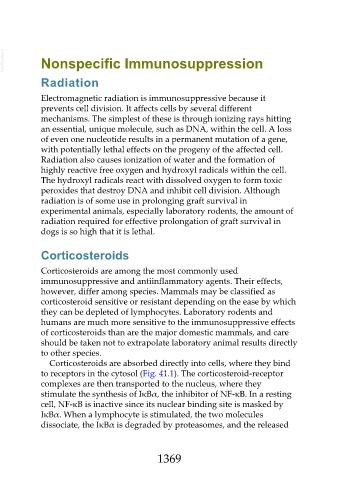Page 1369 - Veterinary Immunology, 10th Edition
P. 1369
VetBooks.ir Nonspecific Immunosuppression
Radiation
Electromagnetic radiation is immunosuppressive because it
prevents cell division. It affects cells by several different
mechanisms. The simplest of these is through ionizing rays hitting
an essential, unique molecule, such as DNA, within the cell. A loss
of even one nucleotide results in a permanent mutation of a gene,
with potentially lethal effects on the progeny of the affected cell.
Radiation also causes ionization of water and the formation of
highly reactive free oxygen and hydroxyl radicals within the cell.
The hydroxyl radicals react with dissolved oxygen to form toxic
peroxides that destroy DNA and inhibit cell division. Although
radiation is of some use in prolonging graft survival in
experimental animals, especially laboratory rodents, the amount of
radiation required for effective prolongation of graft survival in
dogs is so high that it is lethal.
Corticosteroids
Corticosteroids are among the most commonly used
immunosuppressive and antiinflammatory agents. Their effects,
however, differ among species. Mammals may be classified as
corticosteroid sensitive or resistant depending on the ease by which
they can be depleted of lymphocytes. Laboratory rodents and
humans are much more sensitive to the immunosuppressive effects
of corticosteroids than are the major domestic mammals, and care
should be taken not to extrapolate laboratory animal results directly
to other species.
Corticosteroids are absorbed directly into cells, where they bind
to receptors in the cytosol (Fig. 41.1). The corticosteroid-receptor
complexes are then transported to the nucleus, where they
stimulate the synthesis of IκBα, the inhibitor of NF-κB. In a resting
cell, NF-κB is inactive since its nuclear binding site is masked by
IκBα. When a lymphocyte is stimulated, the two molecules
dissociate, the IκBα is degraded by proteasomes, and the released
1369

